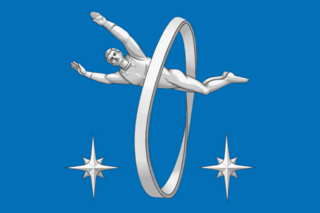Related Research Articles

Local government is a generic term for the lowest tiers of governance or public administration within a particular sovereign state.

Russia is divided into several types and levels of subdivisions.

Urban-type settlement is an official designation for lesser urbanized settlements, used in several Central and Eastern European countries. The term was primarily used in the Soviet Union and later also for a short time in socialist Bulgaria and socialist Poland. It remains in use today in nine of the post-Soviet states.
An okrug is a type of administrative division in some Slavic-speaking states. The word okrug is a loanword in English, alternatively translated as area, district, or region.

In Russia, the oblasts are 46 administrative territories; they are one type of federal subject, the highest-level administrative division of Russian territory.

A krai is a type of federal subject of the Russian Federation. The country is divided into 85 federal subjects, of which nine are krais. Oblasts, another type of federal subject, are legally identical to krais and the difference between a political entity with the name "krai" or "oblast" is purely traditional; both are constituent entities equivalent in legal status in Russia with representation in the Federation Council. During the Soviet era, the autonomous oblasts could be subordinated to republics or krais, but not to oblasts. Outside of political terminology, both words have a very similar general meaning and can often be used interchangeably. When a distinction is desirable, "krai" is sometimes translated into English as "territory", while "oblast" can variously be translated to "province" or "region", but both of these translations are also reasonable interpretations of "krai".

The federal subjects of Russia, also referred to as the subjects of the Russian Federation or simply as the subjects of the federation, are the constituent entities of Russia, its top-level political divisions according to the Constitution of Russia. Kaliningrad Oblast is the only federal subject geographically separated from the rest of the Russian Federation by other countries.
A selsoviet is the shortened name for a rural council and for the area governed by such a council (soviet).

Staraya Russa is a town in Novgorod Oblast, Russia, located on the Polist River, 99 kilometers (62 mi) south of Veliky Novgorod, the administrative center of the oblast. Its population has steadily decreased over the past years, going from 41,538 recorded in the 1989 Census to 35,511 in the 2002 Census to 31,809 in the 2010 Census.
The classification system of inhabited localities in Russia and some other post-Soviet states has certain peculiarities compared with those in other countries.

Kirillov is a town and the administrative center of Kirillovsky District in Vologda Oblast, Russia, located on the shores of Lakes Siverskoye and Dolgoye, 129 kilometers (80 mi) northwest of Vologda, the administrative center of the oblast. Population: 7,728 (2010 Russian census); 8,229 (2002 Census); 8,817 (1989 Soviet census).

Murmansk Oblast is a federal subject of Russia, which is located in the northwestern part of the country, occupying mostly the Kola Peninsula. The oblast itself was established on May 28, 1938, but some kind of administrative organization of the territory existed here since at least the 13th century. As of the 2002 Census, Russians account for the majority of the oblast's population, with the indigenous Sami constituting only a 0.20% minority (1,769 people).

Nikolsk is a town and the administrative center of Nikolsky District in Vologda Oblast, Russia, located on the right bank of the Yug River. Population: 8,511 (2010 Russian census); 8,649 (2002 Census); 8,574 (1989 Soviet census).
A law enforcement agency (LEA) is any government agency responsible for law enforcement within a specific jurisdiction through the employment and deployment of law enforcement officers and their resources. The most common type of law enforcement agency is the police, but various other forms exist as well, including agencies that focus on specific legal violation, or are organized and overseen by certain authorities. They typically have various powers and legal rights to allow them to perform their duties, such as the power of arrest and the use of force.
The municipal divisions in Russia, also called municipal formations, are territorial divisions of the Russian Federation which are formally granted the authority to manage local affairs through local self-government. As of January 1, 2020, there are 20,846 municipal divisions in Russia, including 1,673 municipal districts, 635 urban okrugs, and 33 municipal okrugs.
Town of district significance is an administrative division of a district in a federal subject of Russia. It is equal in status to a selsoviet or an urban-type settlement of district significance, but is organized around a town ; often with surrounding rural territories.

Zvyozdny gorodok, also known by its anglicized name Star City, is a closed urban locality in Moscow Oblast, Russia. It is home to the military research and space training facility known as Star City in English. Population: 6,332 (2010 Russian census).

A district (raion) is an administrative and municipal division of a federal subject of Russia.
References
- 1 2 "Энциклопедический словарь конституционного права". Статья "Административно-территориальное устройство". Сост. А. А. Избранов. — Мн.: Изд. В.М. Суров, 2001.
- ↑ The Republic of Crimea is a federal subject of Russia established on the territory of the Crimean Peninsula, which is disputed between Russia and Ukraine